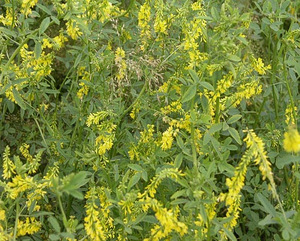Description: Sweet Clover, scientifically known as Melilotus officinalis, is a biennial or short-lived perennial plant belonging to the Fabaceae family. Native to Eurasia, it has become widely naturalized in North America and other regions. Sweet Clover is recognized for its fragrant flowers and is valued for its use as a forage crop, cover crop, and for its ability to improve soil fertility. However, its aggressive growth and potential to become invasive in certain ecosystems have raised concerns.
Habitat and Distribution: Sweet Clover is commonly found in disturbed areas, along roadsides, in meadows, and in agricultural fields. It prefers well-drained soils and full sunlight. Due to its adaptability, Sweet Clover has become invasive in some regions, particularly in disturbed habitats.
Physical Features:
- Leaves: The leaves of Sweet Clover are compound, with three leaflets arranged alternately along the stem. The leaves are finely toothed, giving them a serrated appearance.
- Flowers: The flowers are small, yellow to pale cream in color, and are arranged in elongated clusters. They have a sweet fragrance, which contributes to the plant's name.
Ecological Significance:
- Sweet Clover plays several ecological roles: Nitrogen Fixation: Like other legumes, Sweet Clover forms a symbiotic relationship with nitrogen-fixing bacteria, contributing to soil nitrogen levels.
- Soil Improvement: The deep taproot of Sweet Clover helps improve soil structure and fertility.
Cultural Uses:
- Forage Crop: Sweet Clover is often grown as a forage crop for livestock due to its high nutritional content.
- Cover Crop: Farmers use Sweet Clover as a cover crop to improve soil health and prevent erosion.
- Green Manure: When plowed under before flowering, Sweet Clover acts as a green manure, enriching the soil with nitrogen.
Concerns and Challenges:
Invasiveness: Sweet Clover has the potential to become invasive in certain ecosystems, particularly in areas where it has been introduced.
Control and Management:
- Mechanical Control: Mowing or Cutting: Regular mowing or cutting before Sweet Clover produces seeds can help manage its spread. However, this may need to be done consistently.
- Cultural Practices: Crop Rotation: Implementing crop rotation practices in agricultural settings can disrupt the lifecycle of Sweet Clover and reduce its prevalence.
- Cover Crops: Planting alternative cover crops that do not have invasive tendencies can be considered.
- Chemical Control: Herbicides: Selective herbicides labeled for broadleaf weed control can be used to target Sweet Clover. Carefully follow application instructions to avoid harm to desirable plants.
Preventing Spread:
- Early Detection: Regularly monitoring fields, gardens, and disturbed areas for signs of Sweet Clover is crucial for early detection. Prompt removal or control measures can prevent its spread.
- Minimizing Soil Disturbance: Minimizing soil disturbance during agricultural or construction activities can help reduce the germination of Sweet Clover seeds.
- Management in Pastures: In pastures, proper grazing management can help control the growth of Sweet Clover and prevent it from becoming dominant.
In conclusion, while Sweet Clover has valuable uses in agriculture, its potential invasiveness in certain ecosystems requires careful management. Implementing a combination of cultural practices, mechanical control, and, if necessary, targeted herbicide application can help manage Sweet Clover populations and balance its benefits with the need to prevent its spread in sensitive environments.



